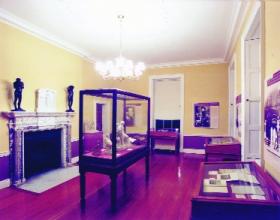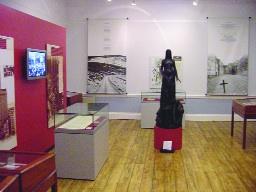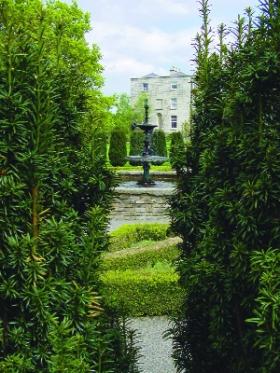Museum Eye
Published in Issue 2 (Mar/Apr 2006), Reviews, Volume 14
The museum is dedicated to the memory of the entire Pearse family. The glass cabinet in the centre of this room displays a maquette of the work of Patrick’s stonemason father, James. (Pearse Museum)
Pearse Museum
St Enda’s Park, Rathfarnham, Dublin 16
01–4934208
Open every day @ 10am. Closed for lunch (1–2pm). Closed @ 5pm (Feb.–Apr. & Sep.–Oct.), 5.30pm (May–Aug.), 4pm (Nov.–Jan.)
by Tony Canavan
The Pearse Museum is situated in 50 acres of parkland that contain playing fields and nature walks. It occupies a simple, elegant Georgian house built in 1786 by wealthy Dubliner Edward Hudson as a country retreat. The house has associations with Robert Emmet (part of its attraction for Patrick Pearse), and a woodland walk was named after him. Pearse’s school, St Enda’s, moved here in 1910 from Cullenswood House, Rathmines, which subsequently became St Ita’s girls’ school. Except for a brief period of British occupation after the 1916 Rising, the house remained in the Pearse family as a school until 1935. It came into the state’s ownership in 1968 and opened as a museum in 1975.
The visitor—once he/she has worked out where the museum is, owing to a lack of adequate signage—approaches the house on foot along a tree-lined avenue and can enjoy views of the Dublin mountains along the way. The entrance hall is occupied by the receptionist and, on my visit, Andy, an attendant, both of whom were more than willing to talk to and guide the visitor around. The house is not huge and, as the museum in effect only occupies the ground floor, it is not huge either: just five small rooms. As it is a museum of the Pearse family (not just Patrick) and of the school, this is asking quite a lot of a small space, and in truth the museum has a fairly sparse collection. Whether this is due to a lack of artefacts or a lack of resources is a moot point.

The flat screen to the left shows newsreel footage of the funeral of O’Donovan Rossa in which Patrick Pearse can be glimpsed for a few seconds.
Nevertheless, the museum does its best with the space and exhibits. There are a lot of photographs and information panels that tell the story of the family and the school, as well as giving a flavour of what life was like then. The first room that you enter is headmaster Patrick Pearse’s study, spartanly furnished with a desk, chair and some bookshelves. The books in here, as elsewhere, belonged to Patrick’s father and reflect an eclectic interest in history, language and religion—copies of the Bible and the Koran sit side by side. The room is dominated by a painting by Beatrice Elvery and other works of art, such as a small sculpture by Willy Pearse, sketches from Belgium and a couple of Jack Yeats’s paintings, all adding to the atmosphere of a cultured study where you can easily imagine Pearse writing or discussing school business with Thomas MacDonagh or one of the other teachers.
An adjoining room, once a classroom, contains memorabilia from the family, including photographs of the parents and children alongside paintings and sketches. Pride of place here goes to a small chair that was a favourite of Mrs Pearse’s. This room leads to a hall that concentrates on the history of St Enda’s scoil do laocha (school for heroes). There are information panels carrying quotations from Pearse that explain how he was influenced by a visit to Belgium and by the work of Maria Montessori in devising his system of education based on the principle of freedom for the student and inspiration from the teacher. The display cabinets here really bring the school to life. You can see the very first roll book, photographs of school plays and sporting events, postcards and raffle tickets (there were always financial problems), teaching aids and even a magic lantern used by such guest lecturers as Sir Roger Casement and Shane Leslie. A poignant reminder of the school’s patriotic legacy is the 1916 medal awarded posthumously to Gerald Keogh, a pupil, who was killed in the Rising.
Four teachers—the Pearse brothers, MacDonagh and Conn Colbert—were executed for their part in the Rising, and another room reflects the political aspect of the family with a range of objects and displays illustrating everything from Patrick’s writings on Irish freedom to his mother’s fund-raising in America. Here too more attention is given to the sisters, Mary Brigid and Margaret. Most interesting of all in this room is newsreel footage of the funeral of O’Donovan Rossa in which Pearse can be glimpsed for a few seconds. It was at this funeral that he delivered his most famous speech, and in a nearby cabinet is its original text in Pearse’s handwriting. Significant also are copies of the last two letters that he wrote before his execution in which it is clear that he had no idea that his brother, Willy, was to be shot too.

The museum occupies a simple, elegant Georgian house (bottom) built in 1786 and situated in 50 acres of parkland containing playing fields and nature walks. (Pearse Museum)
The final room on this floor delves deeper into the family background. There is a diagram outlining the two families of James Pearse—Patrick and his siblings were the products of a second marriage. There are memorabilia from family life and childhood that serve to remind the visitor of Pearse’s humanity, that he was a real person and not just the ‘icon’ of one of the earlier displays. You can learn here about the work of James as a sculptor and see examples of Pearse family art—it was Willy who carried on the family business. Upstairs, one room recreates a boarders’ dormitory, complete with bunk-beds and washstands. On the way there you will pass a replica of the school ‘uniform’. There was no official uniform but the boys were encouraged to wear the traditional kilt and brat (cape), such as those displayed here. Upstairs too a video runs telling the story of the house and school.
Despite the museum’s best intentions, I left feeling unsatisfied. The exhibition could do no more than skim the surface at best, but it seemed either that it assumed a lot of knowledge on the part of the visitor or that it had decided not to engage with crucial aspects of Patrick Pearse’s life. While I applaud the emphasis on Pearse as educator, I could not help but feel that a foreign visitor or schoolchild would leave thinking that Pearse was an eccentric educational pioneer who died as a result of an unfortunate incident in Dublin in 1916. Such a visitor would have no idea that he was a key figure in planning the Rising, was president of the provisional government or read out the Proclamation of Independence. I am told that the museum will close later this year for a complete overhaul. We can only hope that in Ireland after the Good Friday Agreement the resources and will are there to give a more rounded, deeper picture of Patrick Pearse, his family and St Enda’s school.
Tony Canavan is a former Museum Officer of Newry and Mourne District Council.
















